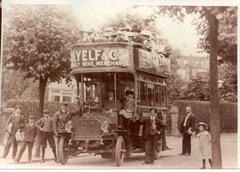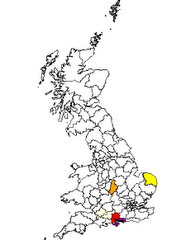
This particular piece of research was triggered by one of my periodic googlings of the name YELF. A chance search had revealed a new reference to a site that seemed to consist of names of soldiers, including one referring to Frederick Yelf. This site was owned by Kevin Asplin and seemed to focus on the IY (whatever that was…) However, of more immediate interest was the entry for ‘Yelf, Frederick 4673, Trooper 41st Coy., 12th Bn. I.Y.’
Now I have a couple of Frederick Yelfs on the file, in fact recent articles have dealt with Freddie Yelf and Frederick Steane Yelf, but I wasn’t aware of any regular army service from any of them, so at first I was rather intrigued as to what sort of dates I was looking at in this particular instance. Trooper meant he was in a cavalry regiment, but the initials IY didn’t ring any obvious bells. Looking at the rest of the site though, especially the home page and it was soon obvious that IY stood for Imperial Yeomanry, units of mounted infantry that served during the Boer War in South Africa from about 1899 to 1908. They were disbanded soon after the conclusion of that particular war so their history was a short, although fascinating one.
I was able to do some background reading on the Imperial Yeomanry on Wikipedia and other specialist sites and found out that they were initially a response to the obvious lack of mounted, mobile infantry required to campaign across the veldt of South Africa. The British government turned to the local units of Cavalry Yeomanry, a sort of 19th century Territorial or part-time local militia, as a means of raising troops quickly. These Yeomanry units had tended to attract the reasonably well-off sons of the middle-class who had undergone some basic military training and turned out for shooting competitions and parades. In the heady atmosphere of patriotic fervour large numbers volunteered for service in South Africa but their terms and conditions of service were not the same as their regular army compatriots. In the first place they only signed on for a year and in the second place they supplied both their own horse and their own uniform! No doubt they hoped that a year would be enough to see off the Boers, serve the Queen and have a bit of an adventure at the same time and they signed up in large numbers.
The different Companies of the Imperial Yeomanry were drawn from specific Yeomanry regiments. The 41st Company of the 12th Battalion Imperial Yeomanry, Frederick’s company, were drawn from the Hampshire Carabiniers (a carbine being a shortened musket for use by mounted troops) and they seem to have been based in Southampton, but who no doubt had sections over the rest of the county as well). As it turned out, the Frederick in question was Frederick Yelf, son of Richard Yelf, wine-merchant of Sandown, Isle of Wight. Frederick was born in Brading in 1878 and was 22 years and 9 months old when he signed his short–term Attestation papers in Newport on 8th January 1900. This document is preserved in the National Archive Office along with those of Frederick’s colleagues, and gives information about Frederick at the beginning and end, of his service. From the document we know that Frederick was 5’8” tall and weighed 144lbs, of fair complexion with blue eyes and brown hair and was declared fit for service by Lt. Col. Will Woods following his successful medical. The attestation documents broke Frederick’s service down into three sections; 24 days in England, 1 year 23 days in South Africa and a further 36 days back in England before his final discharge on 31-3-1901. His conduct over this period was described as ‘very good’ and his campaigns were recorded as ‘S. Africa, Senekal, Biddulphsberg’
I spent some time looking up these campaigns and found a very informative and descriptive set of accounts of the battle of Biddulphsberg as well as another showing the battlefield as it is today (complete with Boer anthem!). It is impossible to know what experiences Frederick had in the campaign but the note of his medals and clasps on the Attestation papers – namely the Queens South African medal and four clasps (the bars with names on attached to the ribbon) pinpoint exactly when and where he served. The following information is taken from the North-East Medals website where I was able to find out just what these clasps refer to. Frederick’s four clasps consisted one campaign clasp, two regional clasps and one date clasp, namely;
Wittebergen : All troops who were inside a line drawn from Harrismith to Bethlehem, thence to Senekal and Clocolan, along the Basuto border, and back to Harrismith, between lst and 29th July, 1900, both dates inclusive.
Cape Colony : All troops in Cape Colony at any time between 11th October, 1899, and 31st May, 1902, inclusive, who had not received a clasp for a specific action in the Cape Colony, or the " Natal " clasp.
Orange Free State : All troops in Orange River Colony at any time between 28th February, 1900 and 31st May, 1902, inclusive who had not received a clasp for a specific action in the Orange River Colony.
South Africa 1901 : All troops who served in South Africa between 1st January, 1901, and 31st December, 1901, both dates inclusive, who were not eligible for the King's South Africa Medal.
By all accounts the Boer’s choice of guerrilla tactics left many of the Imperial Yeomanry with only routine and boredom for much of the time and when their time was up they either applied for release or a transfer to the more exciting life of a mounted policeman. Frederick seems to have preferred to return to his life in the wine-trade and his documentation notes that he was
“Discharged at his own request from further service in connection with the War in South Africa”



1 comment:
Hello. My grandfather was in the same Company as Frederick, as Trooper 6982, Walter Edward Maxfield. He had a good book which you can get new copies of - 'With the Eighth Division' by E.C.Moffett which has quite a few mentions of the 41st with Gen. Rundle's 'Starving' 8th. There's another which I haven't got yet, called 'With Rundle's Eighth Division' by Thomas Charles Wetton of the 34th I.Y. (The War ended on 31st May 1902).
Best wishes, Pete Maxfield.
Post a Comment